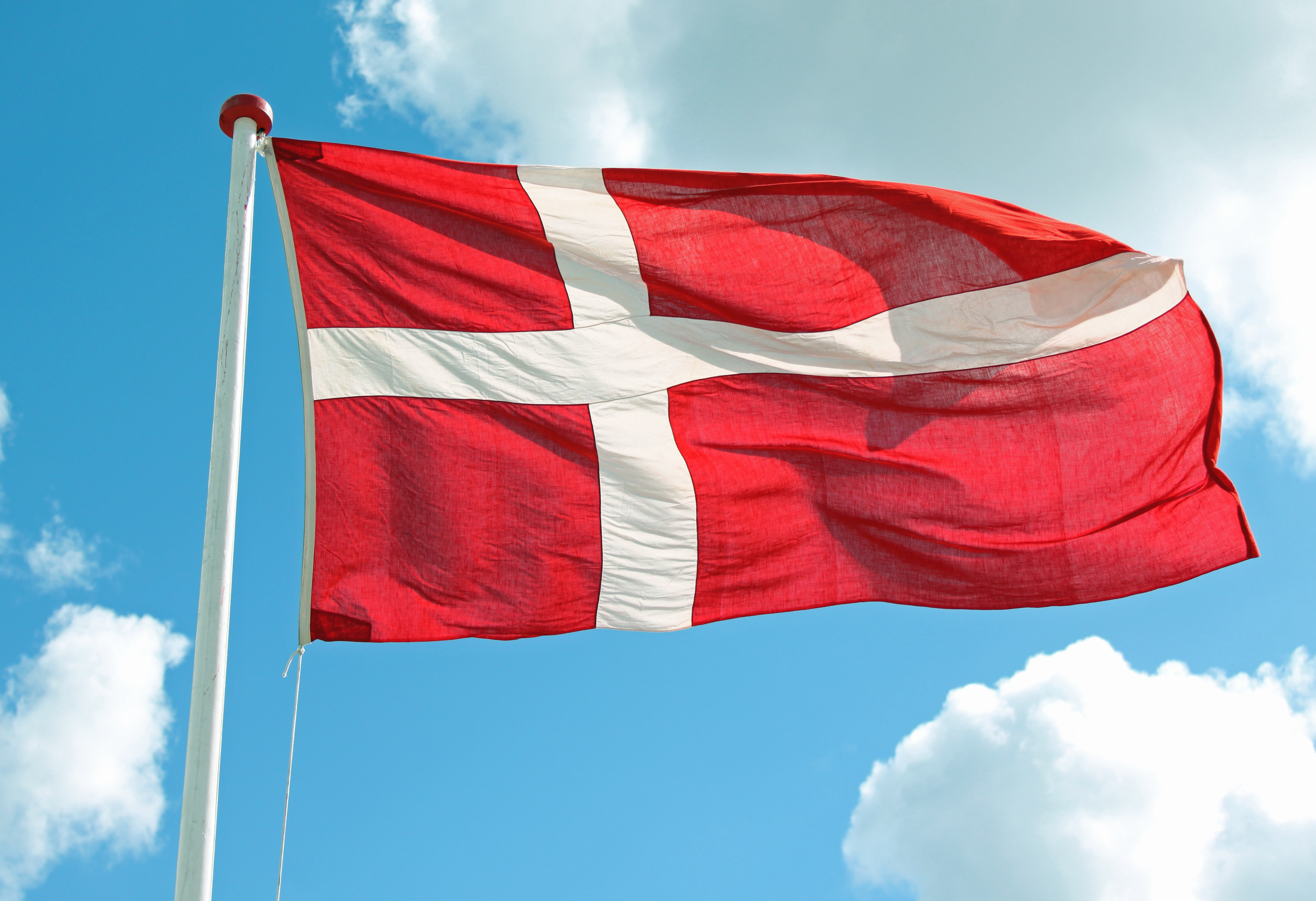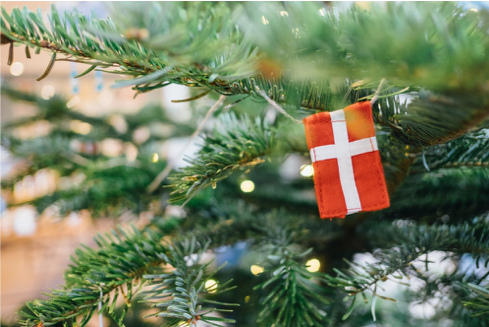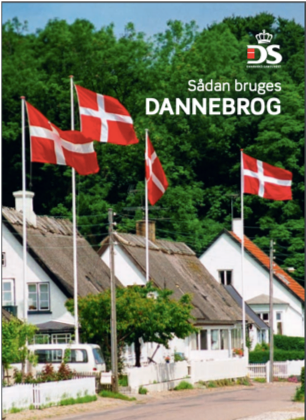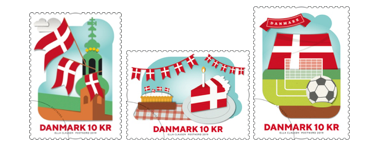The Dannebrog in Danish culture
Denmark exhibits a unique culture where the national flag, known by its local name 'Dannebrog', has become an everyday symbol used by Danes. In addition to official functions and ceremonies, Danes use their national flag for birthday parties, graduation ceremonies, advertisements and decorations, among many other occasions. Although personal use of the national flag is also common in other Nordic countries, especially Norway and Sweden, the everyday use and importance of the national flag in Denmark is perhaps unmatched. Some consider that such use of the national flag is personal and festive, while others consider it can have nationalistic undertones.

The legend of the Dannebrog
Besides being referred to as the oldest national flag in continuous use, Dannebrog also has an interesting legend behind its origin. According to this claim, the Dannebrog descended from the sky during the thirteenth-century Battle of Lyndanisse in Estonia. Legend has it that the Danish King Valdemar II was approaching an imminent defeat before the archbishop Anders Sunesen lifted his arms up to seek help from God, and, while his arms were lifted, the Danes started having the upper hand. But once he dropped his arms, the Estonians again started taking control of the battle. The archbishop again lifted his arms up and this time God responded by sending a red banner with a white cross on it down from the sky. The legend also has it that King Valdemar II caught this descending banner in his arms before it could touch the ground. Owing to this heavenly magical intervention, Valdemar II managed to avert an inevitable defeat and vanquished his pagan rivals.
This story continues to be cited and is quite popular among the Danes; it does not seem to matter whether it is historically accurate or not. As some commentators have suggested, it adds something to people's perception of the flag and its legitimacy regardless. According to Torben Kjersgaard Nielsen, historian at Aalborg University and the author of the book Dannebrog from 2018, what is really important is that the tale is a good story, combining both religion and mythology.
This legendary claim is also glorified in art and literature in Denmark. By portraying the ‘heavenly origin’ of the Danish national flag, C. A. Lorentzen’s 1808 painting gave visual form to the Dannebrog’s ‘history’ connecting it more vividly with the Danes. B.S. Ingemann’s novel from 1826, Valdemar Seier (Valdemar the victorious), which became very popular among the Danes throughout the nineteenth and twentieth centuries, was also centred around glorifying and retelling the ‘history’ of the Danish national flag. Stories hailing the Dannebrog and the legendary claim behind its origin also feature in children’s comics and books in Denmark.

PICTURE: C. A. Lorentzen’s painting from 1808 illustrating the Dannebrog falling from the sky during the Battle of Lyndanisse in 1219. On the left in the background is archbishop Anders Sunesen with raised hands, and in the foreground, Bishop of Roskilde Peder Jacobsen pointing at the Dannebrog while informing king Valdemar II.
The name 'Dannebrog' itself first appears in a source from 1380. The name is composed of the words 'danne-' and '-brog', where the second part of the word denotes a piece of clothing, fabric or cloth. It has been suggested that the first part is the same as in words like ‘Dannevirke’ (the name for the ancient dyke that runs south of the Danish border in Germany) and ‘Danmark’, and this has led to the traditional interpretation of the word as: 'the flag of the Danes'. It is also possible that 'dan' denotes the Frisian word for 'red' or 'red-colored'. (Translated from danmarkshistorien.dk) |
The everyday use of the Dannebrog today
The Dannebrog can be found virtually everywhere in Denmark: Apart from decorating doors and walls with paper flags on various occasions, Danes also use the design of their national flag on birthday cakes and birthday cards. They also put table flags and Dannebrog-printed table coverings and napkins on dining tables for birthdays or special occasions. The Dannebrog is also to be found in potted plants and lawns outside a venue to indicate the way to a party. At Christmas time, many Danes also use the Dannebrog to decorate their homes, gardens or Christmas trees. Some traditional songs also refer to the flag.

PICTURE: The use of Dannebrog as a garland around Christmas trees in Denmark. Photo: Paul Hanaoka, Unsplash
Beyond festive occasions, the Dannebrog is also used to decorate shopping streets, offices and cars in Denmark. During sale periods, shopkeepers sometimes put Dannebrogs on their shopfronts to alert shoppers. Moreover, the Dannebrog is also waved at graduation ceremonies, presented to friends and family to welcome them home, and flown at half-mast for funerals. Because of such diverse uses, variants of the national flag can be found in various shapes and sizes in Denmark.
Furthermore, different sub-national organisations like municipalities, scouts’ groups, local bands and others often make and use their own variant of the Dannebrog, which may include the group's initials or logo. Because of such everyday use, the Dannebrog is sometimes referred to as a festive symbol first and foremost, and only then as a national symbol.
Like other countries, Denmark also celebrates national days and festivals, and the Danish government has made a list of official ‘flag days’ on which all public institutions must fly the Dannebrog and public buses are decorated with mini Dannebrogs. An independent organisation, Danmarks-samfundet has played a vital role in making the national flag important in Danish culture. Established in 1908 to strengthen Danish nationalism, Danmarks-samfundet or The Society of Denmark disseminates knowledge about the use of the Dannebrog and the associated legendary claim. Besides organising leaflets about the Dannebrog and distributing the national flag to various groups, associations and citizens, the organisation has also been celebrating the anniversary of the birth of the Dannebrog on Valdemar’s day (June 15) annually, since 1913. The organisation claims that the Dannebrog today represents Denmark's entire development, and that the Dannebrog is the people’s flag.
The Danish Flag Code
Although this suggests a very free use of the Danish flag, there are surprisingly quite strict rules with respect to the flying of the Dannebrog — although they are not as strict as in some other countries like India, Iran, or Germany. In Denmark, it is a general rule that one cannot use the national flag of any other country for private use without obtaining permission from the police. That said, the flying of the other Nordic flags (including those of Greenland and the Faroe Islands) is allowed without special permission because of the Nordic region’s interrelated histories and cultures.

With respect to flying the national flag of any other country on public buildings, the Flag Code makes it compulsory to fly a Dannebrog of at least the same size as the other country’s national flag alongside it and to follow certain measures, such as, unfurling the Dannebrog before the other national flag, raising the Dannebrog on a flag pole which is not smaller than that of the other flag, and giving the Dannebrog the most prestigious placement of the two. Since flying the national flag post-sunset is considered a disgrace to the nation, the Danish Flag Code also makes it compulsory for public institutions to furl down the Dannebrog before sunset, and to not put it up before 8 am or sunrise, if it occurs later than that. This is not compulsory for private use of the flag where one is permitted to decide for oneself, but there is definitely a popular perception that the flag should go down before sunset.
PICTURE: A non-governmental organisation ‘Danmarks-Samfundet’ (The Society of Denmark) provides a PDF guide on how the Dannebrog should be used. It touches upon topics like official flag dags, different ways to fly the flag on a variety of occasions and disposal of the flag. Photo: Danmarks-Samfundet.dk
Is the everyday use of Dannebrog nationalistic?
So, what does this personal and everyday use of the Dannebrog tell us about the Danes? Since national flags are loaded with collective meanings and emotions, an important question arises about whether the use of the Dannebrog in all these diverse contexts can remain a personal and festive affair only. Highlighting the importance of national flags Michael Billig, in his 1995 book Banal Nationalism, has argued that national flags are visual reminders of constant “flaggings” of nationhood. He also emphasises the importance of “un-saluted” and “un-waved” national flags, which provide “banal reminders of nationhood”. The festive and everyday use of the Dannebrog, besides serving simply as a reminder of Danish nationhood, could therefore be said to solidify the idea of the nation state by promoting informal nationalism - which, in turn, serves formal nationalism to at least some extent.

PICTURE: Three postal stamps released in January 2019 showing how the Danes use the Dannebrog on respectively Christiansborg (the parliament building), on birthdays and to do with sports. Photo: Postnord.dk
Furthermore, Cerulo (1995) has argued that the national flag facilitates the process of commemorating and reinforcing the imagination of oneness by focusing commonality on a tangible expression. Taking this argument further, Therborn (1995) argues that:
“A collective identity is not just an identity held in common in their souls by an aggregate of individuals. As a rule, it has also a public thing manifested in and sustained by public rituals.” (p.223).
It can be convincingly argued, then, that it is through the private and public rituals surrounding the Dannebrog that the Danish identity of oneness is manifested and reproduced everyday in its banal form.
Caution should be taken, however, with such an interpretation, as elsewhere - both academically and politically - the argument has been made that the lack of use of national flags can equally point to a strong sense of national identity; where, for example, it is not considered necessary to continually reinforce national identity through the use of flags (See Erikson & Jenkins, 2007, for more on this).
Moreover, the positive nuances of ‘oneness’ and a collective nation can all too easily slip over into populist nationalism – but this does not necessarily have to be the case. Importantly, since ‘nation’ and ‘nationalism’ are frequently contested concepts, a binary choice between ‘nationalistic’ and ‘festive’ also seems too simplistic and inadequate. Owing to the use of the Dannebrog in a myriad of everyday contexts in Denmark, Danish historian Torben Kjersgaard Nielsen has suggested that everyone uses and interprets the Danish flag in their own way and, paradoxically, this is what makes it a uniting symbol.
Further reading:
- G. Therborn, European Modernity and Beyond: The Trajectory of European Societies, 1945–2000. (London: Sage Publications, 1995).
- K. Cerulo, Identity Designs: The Sights and Sounds of a Nation (New Brunswick, New Jersey: Rutgers University Press, 1995).
- M. Billig, Banal Nationalism (London: Sage Publications, 1995).
- T.H. Eriksen, and R. Jenkins, eds., Flag, Nation and Symbolism in Europe and America (London: Routledge, 2007).
- Torben Kjersgaard Nielsen, Dannebrog (Aarhus University Press, 2018).
Links:
- More about the Dannebrog on denmark.dk: 'The Flag that Fell from the Sky'
- Article 'Dannebrog' by Stefan Pajung (In Danish - danmarkshistorien.dk, 2019).
- Article 'Dannebrog som folkeligt erindringssted' [The Dannebrog's role in popular remembrance] by Torben Kjersgaard Nielsen (In Danish - danmarkshistorien.dk, 2018).
- Danmarks Samfundet [The Society of Denmark], where you can find rules explaining how to use the Dannebrog (In Danish).